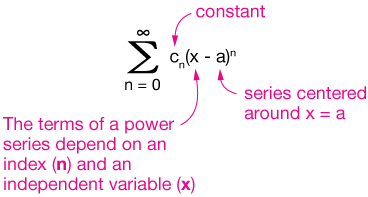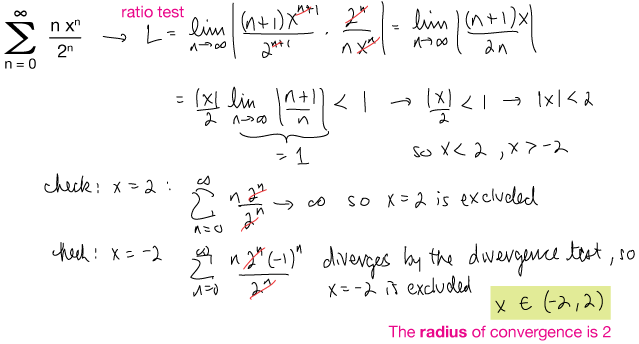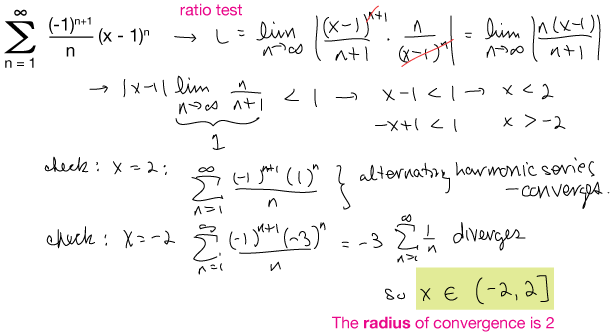Power series and interval or radius of convergence
If you're reading this page, we assume that you're familiar with Taylor series and MacLaurin series. Those are both power series, depending on both an index, $n$, that changes by 1 unit per term, and on an independent variable, $x$. That is, a power series is a function of $x$.
The general form of the terms of a power series are shown in this figure. In this section we'll explore a few examples of power series, and then discuss how to find the radius of convergence — the range of the variable x over which the series converges. This might be a small range, or an infinite one.
We'll find those radii or intervals of convergence mostly using the ratio test, so if you need to, you might want to review that now.

Recall that the difference between a general Taylor series and a MacLaurin series is that in the latter, $a = 0$.
A power series is a function of an independent variable, C. It may or may not converge, depending on the value of $x$.
Convergence of a power series
No infinite series is very useful if it doesn't converge to some value asymptotically, so we're interested in finding which values of $x$ will cause a power series to converge. Generally, we're trying to find a radius of convergence, $R$. We design a power series to converge at it's central point, $a$; the question is how far from $a$ can we go for it to still converge?
We can say that if
$$a - R \lt x \lt a + R$$
then the series converges, and if
$$x \lt a - R \; \; \text{ or } \; \; x \gt a + R$$
then the series diverges.
The trick will be to determine $R$. To do that, we'll use (mainly) the ratio test for convergence, summarized in the box below.
Recall that the idea behind the ratio test is that we take the limit as $n \rightarrow \infty$ of the (n+1)th term of the series divided by the nth term. If that limit (which we call $L$) is less than 1, then the series converges absolutely. If it's greater than 1, the series diverges, and if it's equal to 1, the ratio test is inconclusive.
We can perform that test with a power series, setting $L = 1$, and find the limits on convergence.
The ratio test
$$\text{Let } \; L = \lim_{n\to\infty} \, \left| \frac{a_{n + 1}}{a_n} \right|$$
Then there are three possibilities for the limit, $L$:
If
If
Example 1
 converge?
converge?
Another way to state this problem (and more commonly-used) is "Determine the radius of convergence of the series ..."
- divergence test
- integral test
- comparison test
- limit comparison test
- ratio test
- root test
- alternating series test
Usually, for power series, the best way to determine convergence will be the ratio test, and sometimes the root test.
In this case the ratio test gives us
$$\lim_{x\to\infty} \frac{(x + 5)^{n + 1}}{1 + (n + 1)^3} \cdot \frac{1 + n^3}{(x + 5)^n} \lt 1$$
If the limit is less than 1, then the series converges, and we can solve for the x-values, if any, that make that true. Importantly, if the limit is equal to 1, then the ratio test is inconclusive. In these cases, we'll have to check each endpoint of the interval we obtain, possibly again using the ratio test, but we can always hope it's more obvious at that point. Reducing this limit using the laws of exponents gives:
$$= \lim_{x\to\infty} \frac{(x + 5)(1 + n^3)}{1 + (n + 1)^3}$$
Now we'll need to expand the expression in the denominator:
$$= \lim_{x\to\infty} \frac{n^3(x + 5) + x + 5}{n^3 + 3n^2 + 3n + 1}$$
From here we can use L'Hopital's rule a couple of times:
$$= \lim_{x\to\infty} \frac{3 n^2 (x + 5)}{3 n^2 + 6n + 3}$$
... and again, because this is an (∞/∞) limit:
$$= \lim_{x\to\infty}\frac{6n (x + 5)}{6n + 6}$$
Now the $(x+5)$ term doesn't play any role in the limit, so we can move it outside:
$$= |x + 5| = \lim_{x\to\infty}\frac{6n}{6n + 6} \lt 1$$
The limit is 1, so we have
$$|x + 5| = 1 \; \longrightarrow \; x = -6, \; -4$$
So a potential interval of convergence is $x$ between and including -6 and -4, but we do have to check those endpoints, because they would cause our limit to equal 1, rendering the ratio test inconclusive. That amounts to
$$\sum_{n = 0}^{\infty} \frac{(±1)^n}{1 + n^3}$$
This series converges for $x = -6$ by the alternating series test and for $x = -4$ by comparison with a convergent p-series, so our interval of convergence is
$$\bf x \in [-6, \; -4]$$
For any other values of $x$, this series will diverge. The radius of convergence is the distance of the endpoints of the interval from the central point of the power series expansion, $a = 5$, so $R = 1$.
A power series converges over some interval of its domain, centered around the central point of the expansion, $a$. The interval of convergence is $[a-r, a+r]$, where $a-r$ and $a+r$ may or may not lead to convergence, and $r$ is called the radius of convergence.
We use good bracket notation to indicate which endpoints are included and which not: $[a, b]$; $[a, b)$; $(a, b]$; $(a, b)$, where [ means included in the interval and ( means not.
Example 2
 .
.
$$\lim_{x\to\infty} \left| \frac{x^{n + 1}}{3^{n + 1}} \cdot \frac{3^n}{x^n} \right| \lt 1$$
This easily reduces to
$$\left| \frac{x}{3} \right| \lt 1 \; \longrightarrow \; x \lt 3, \; x \gt -3$$
Now we have to check $x = 3$ and $x = -3$:
$$\sum_{n = 0}^{\infty} \frac{3^n}{3^n} = \sum_{n = 0}^{\infty} 1^n \; \; \text{diverges}$$
and
$$\sum_{n = 0}^{\infty} \frac{(-3)^n}{(-3)^n} = \sum_{n = 0}^{\infty} 1^n \; \; \text{diverges}$$
So the interval of convergence does not include the endpoints:
$$\bf x \in (-3, \; 3)$$
The radius of convergence is $R = 3$. You might have notice that the series could have been written like this:
$$\sum_{n = 0}^{\infty} \, \left( \frac{x}{3} \right)^n$$
which is a geometric series that converges as long as $-3 \lt x \lt 3$.
By the way, the root test would have worked just fine to achieve the same result with this series.
Example 3
 .
.
$$\lim_{x\to\infty} \left| \frac{x^{n + 1}}{(n + 1)!} \cdot \frac{n!}{x^n} \right| \lt 1$$
Recall that $(n+1)! = (n+1)\cdot n!$, and apply the laws of exponents to the $x$-terms to simplify:
$$\lim_{x\to\infty} \left| \frac{x}{(n + 1)n!} \cdot \frac{n!}{1} \right| \lt 1$$
We can pull the $|x|$ outside of the limit (the limit doesn't depend on $x$) to get:
$$|x|\,\lim_{x\to\infty}\frac{1}{n + 1} = 0$$
Now zero is always less than 1, our condition for convergence, so no matter what $x$ is, this series always converges. That's not surprising, actually; the factorial function is a very fast-growing function. The radius of convergence is infinite, $R \rightarrow \infty$.
Example 4

$$\lim_{x\to\infty} \left| \frac{(x - 1)^{n + 1}}{(n + 1)\cdot 4^{n + 1}} \cdot \frac{n \cdot 4^n}{(x - 1)^n} \right| \lt 1$$
Using the laws of exponents gives
$$\lim_{x\to\infty} \left| \frac{n (x - 1)}{(n + 1)\cdot 4} \right| \lt 1$$
If we extract the $|x - 1|$ the limit is easy to find, and we get:
$$|x - 1|\frac{1}{4} \lt 1$$
Solving this by multiplying both sides by 4 and resolving the absolute value [recall that that means $x - 1 \lt 4$ and $-(x - 1) \lt 4$], we get our range:
$$|x - 1| \lt 4 \; \; \; x \gt 3, \; x \lt 5$$
Now we need to check those endpoints using the ratio test. If $x = 3$, then we have the harmonic series multiplied by the convergent geometric series with terms $(1/2)^n$, which is convergent by comparison to the latter, so $x = 3$ is included in the radius of convergence.
$$\sum_{n = 0}^{\infty} \frac{2^n}{n \cdot 4^n} = \sum_{n = 0}^{\infty} \frac{1}{n} \left( \frac{1}{2} \right)^n$$
Now $x = 5$, leads to the non-convergent harmonic series,
$$\sum_{n = 0}^{\infty} \frac{4^n}{n \cdot 4^n} = \sum_{n = 0}^{\infty} \frac{1}{n}$$
so 5 is not included, therefore the interval of convergence is
$$\bf x \in [3, \; 5)$$
Practice problems
Determine the interval of convergence of each of these power series. Express the result in bracket form: $[a, \; b]$, $[a, \; b)$, $(a, \; b]$ or $(a, \; b)$.
-
$$\sum_{n = 0}^{\infty} \frac{n^3 x^{3n}}{n^4 + 1}$$
Solution
$$\sum_{n = 0}^{\infty} \, \frac{n^4 x^{3n}}{n^4 + 1} \; \rightarrow \; L = \lim_{n\to\infty} \left| \frac{(n + 1)^3 \, x^{3n + 3}}{(n + 1)^4 + 1} \cdot \frac{n^4 + 1}{n^3 \, x^{3n}} \right|$$
$$ \begin{align} &= \lim_{n\to\infty} \left| \frac{x^3 (n + 1)^3 (n^4 + 1)}{[(n + 1)^4 + 1] n^3} \right| \\ \\ &= |x^3| \lim_{n\to\infty} \frac{(n^3 + 2n^2 + n)(n^4 + 1)}{(n^4 + 4n^3 + 6n^2 + 4n + 2)(n^3)} \; \rightarrow O\left(\frac{n^7}{n^7}\right) \\ \\ &= |x^3| \lt 1 \end{align}$$
In evaluating the limit above, the $O(n^7/n^7)$ means that the limit contains a highest-order term of the order of n7, and so does the denominator, so the limit will turn out to be 1. That means:
$$ \begin{matrix} x^3 \lt 1 \; \rightarrow && x \lt 1 \\ x^3 \gt -1 \; \rightarrow && x \gt -1 \end{matrix}$$
Now we need to check both of these limits:
$$\text{x = 1:} \; \sum_{n = 0}^{\infty} \frac{n^3}{n^4 + 1} \; \rightarrow \lim_{n\to\infty} \frac{\frac{n^3}{n^4 + 1}}{\frac{1}{n}} = \lim_{n\to\infty} \frac{n^4}{n^4 + 1} = 1$$
The series diverges when x = 1.
$\text{x = -1:}$ This would be an alternating version of the series with terms $\frac{n^3}{n^4 + 1},$ which converges by the alternating series test.
Radius of convergence = 1,
Interval of convergence: $x \in [-1, 1).$ -
$$\sum_{n = 1}^{\infty} \frac{n(x + 4)^n}{4^{n - 1}}$$
Solution
Use the root test for this one:
$$\sum_{n = 1}^{\infty} \, \frac{n(x + 4)^n}{4^{n - 1}} \; \rightarrow \; L = \lim_{n\to\infty} \left| \frac{n(x + 4)^n}{4^{n - 1}}\right|^{\frac{1}{n}} \lt 1$$
$$ \begin{align} &= \lim_{n\to\infty} \left| \frac{n^{\frac{1}{n}}(x + 4)}{4^{1 - 1/n}} \right| \\ \\ &= \lim_{n\to\infty} \frac{n^{\frac{1}{n}}(x + 4)}{\frac{4}{4^{1/n}}} = |x + 4| \lim_{n\to\infty} \frac{(4n)^{1/n}}{4} \\ \\ &= \frac{|x + 4|}{4} \lim_{n\to\infty} (4n)^{1/n} \lt 1 \end{align}$$
The limit above goes to zero, so we have
$$\frac{|x + 4|}{4} \lt 1 \; \rightarrow \; |x + 4| \lt 4$$
So we have $x \lt 0$ and $x \gt -8.$
Now we need to check both of these endpoints:
$$\text{x = 0:} \; \sum_{n = 1}^{\infty} \frac{n\, 4^n}{4^{n - 1}} = \sum_{n = 1}^{\infty} \, 4n \; \; \text{ diverges}$$
The series diverges when x = 0.
$$\text{x = -8:} \sum_{n = 1}^{\infty} \frac{4^n(-1)^n}{4^{n - 1}} = \sum_{n = 1}^{\infty} (-1)^n (4) \; \; \text{ diverges}$$
The series diverges when x = -8.
Radius of convergence = 4,
Interval of convergence: $x \in (-8, 0).$ -
$$\sum_{n = 0}^{\infty} \frac{(n!)^2 x^n}{(2n)!}$$
Solution
$$\sum_{n = 0}^{\infty} \, \frac{(n!)^2 \, x^n}{(2n)!} \; \rightarrow \; \lim_{n\to\infty} \left| \frac{[(n + 1)!]^2 \, x^{n + 1} (2n)!}{[2(n + 1)]! (n!)^2 x^n} \right| \lt 1$$
Now let's pause and consider those squared factorials:
$$ \begin{align} [(n+1)!]^2 &= [(n + 1)n!]^2 = (n + 1)^2 (n!)^2 \\[5pt] [2(n + 1)]! &= (2n + 2)! \\[5pt] &= (2n + 2)(2n + 1)(2n)! \end{align}$$
So our limit can be rewritten like this:
$$ \begin{align} &= \lim_{n\to\infty} \left| \frac{(n + 1)^2 (n!)^2 x^{n + 1} (2n)!}{(2n + 2)(2n + 1)(2n)!(n!)^2 x^n} \right| \\[5pt] &= \lim_{n\to\infty} \left| \frac{(n + 1)^2 x}{(2n + 2)} \right| \\[5pt] &= |x| \lim_{n\to\infty} \frac{(n + 1)^2}{4n^2 + 6n + 2} \lt 1 \end{align}$$
The limit is $\frac{1}{4},$ so our values of x are:
$$x \lt 4 \; \; \text{ and } \; \; x \gt -4$$
So the radius of convergence is 4, but to find the interval of convergence, we need to check those endpoints.
$$ \begin{align} x = 4: \; \rightarrow \; \lim_{x\to\infty} \frac{4^n}{4} \; \rightarrow \; \infty \\[5pt] x = -4: \; \rightarrow \; \lim_{x\to\infty} \frac{(-4)^n}{4} \; \rightarrow \; \infty \end{align}$$
These both diverge, so we have:
The radius of convergence is 4
The interval of convergence is $x \in (-4, 4).$
-
$$\sum_{n = 0}^{\infty} \frac{n x^n}{2^n}$$
Solution
$$ \require{cancel} \begin{align} L &= \lim_{n \to \infty} \left| \frac{(n+1)x^{\cancel{n}+1}}{2^{\cancel{n}+1}} \cdot \frac{\cancel{2^n}}{nx^\cancel{n}} \right| \\[5pt] &= \lim_{n \to \infty} \left|\frac{(n+1)x}{2n} \right| \\[5pt] &= \frac{|x|}{2} \lim_{n \to \infty} \left| \frac{n+1}{n} \right| \lt 1 \\[5pt] &\rightarrow \frac{|x|}{2} \lt 1 \rightarrow |x| \lt 2 \\[5pt] &\text{so } \; x \lt 2, \; x \gt -2 \end{align}$$
$$\text{Check: } x=2: \; \sum_{n=0}^{\infty} \frac{n \cancel{2^n}}{\cancel{2^n}} \rightarrow \infty$$
So $x=2$ is excluded.
$$\text{Check: } x=-2 \; \sum_{n=0}^{\infty} \frac{n \cancel{2^n} (-1)^n}{\cancel{2^n}} \rightarrow \infty$$
diverges by the divergence test, so $x=-2$ is excluded. The interval and radius of convergence are
$$x \in (-2, \; 2), \; \; r = 2$$
-
$$\sum_{n = 0}^{\infty} \left( \frac{2x}{5} \right)^n$$
Solution
$$ \begin{align} L &= \lim_{n \to \infty} \left| \left( \frac{2x}{5} \right)^m \right|^{\frac{1}{n}} \\[5pt] &= \lim_{n \to \infty} \left| \frac{2x}{5} \right| \lt 1 \end{align}$$
So we have
$$ \begin{align} |2x| \lt 4 &\rightarrow |x| \lt \frac{5}{2} \\[5pt] x &\lt \frac{5}{2}, \; x \gt -\frac{5}{2} \end{align}$$
Check $x=\frac{5}{2}$:
$$\sum_{n=0}^{\infty} \left( \frac{2 \left(\frac{5}{2} \right)}{5} \right)^n = \sum_{n=0}^{\infty} 1^n \text{ diverges}$$
Check $x=-\frac{5}{2}$:
$$\sum_{n=0}^{\infty} \left( \frac{2 \left(-\frac{5}{2} \right)}{5} \right)^n = \sum_{n=0}^{\infty} (-1)^n \text{ diverges}$$
The radius of convergence is $\frac{5}{2}$, and the interval is $x \in \left( -\frac{5}{2}, \frac{5}{2} \right)$
-
$$\sum_{n = 0}^{\infty} \frac{(-1)^{n + 1}}{n}(x - 1)^n$$
Solution
$$ \begin{align} L &= \lim_{n \to \infty} \left| \frac{(x-1)^{\cancel{n}+1}}{n+1} \frac{n}{(x-1)^\cancel{n}} \right| \\[5pt] &= \lim_{n \to \infty} \left| \frac{n(x-1)}{n+1} \right| \\[5pt] &\rightarrow |x-1| \lim_{n \to \infty} \frac{n}{n+1} \lt 1 \\[5pt] &\rightarrow x-1 \lt 1 \rightarrow x \lt 2 \\[5pt] &\rightarrow -x+1 \lt 1 \rightarrow x \gt -2 \end{align}$$
Check $x=2$:
$$\sum_{n=1}^{\infty} \frac{(-1)^{n+1} (1)^n}{n}$$
This is a convergent alternating series.
Check $x=-2$:
$$\sum_{n=1}^{\infty} \frac{(-1)^{n+1} (-2)^n}{n} = -3 \sum_{n=1}^{\infty} \frac{1}{n}$$
— diverges. So the radius of convergence is 2 and the interval is
$$x \in (-2, \; 2]$$

![]()
xaktly.com by Dr. Jeff Cruzan is licensed under a Creative Commons Attribution-NonCommercial-ShareAlike 3.0 Unported License.© 2012-2019-2025, Jeff Cruzan. All text and images on this website not specifically attributed to another source were created by me and I reserve all rights as to their use. Any opinions expressed on this website are entirely mine, and do not necessarily reflect the views of any of my employers. Please feel free to send any questions or comments to jeff.cruzan@verizon.net.


